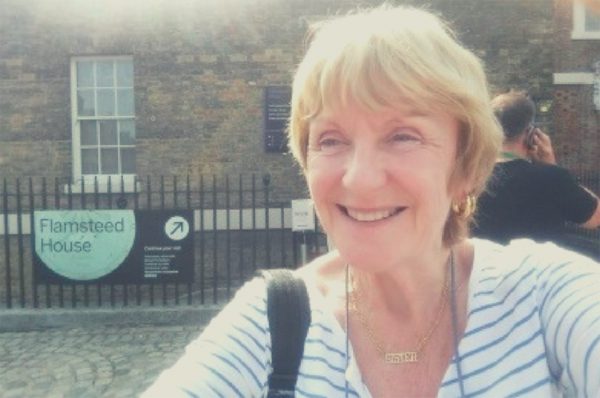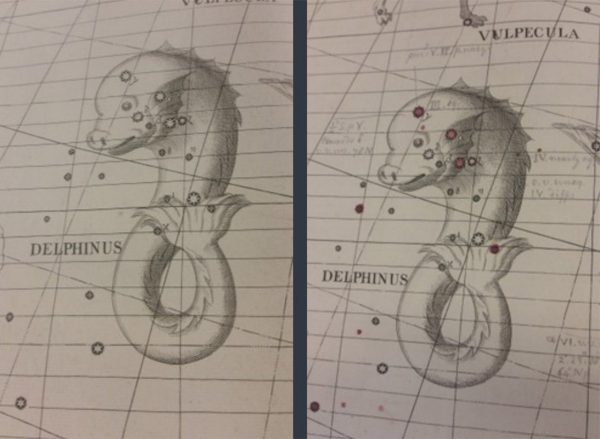
Newsletter Sign Up
Sign up today to our quarterly newsletter
View more

I had always had this visit on my bucket list. But it didn’t happen until August this year. I booked my entry for the Observatory and my viewing time at Caird Hall. I had two particular goals in mind with this visit. First, you may ask what is at Caird Hall? Well, one of my interests as a volunteer at the Observatory is the Atlas Coelestis and here I was with the opportunity to view three of them in one day. I was so excited I was like a kid in a lolly shop and I was not disappointed…secondly I have a fascination with the Harrison clocks and after reading Longitude by Dava Sobell, I had to see them.
So there you have most of my day. At Caird Hall, you have to book ahead of time to view books so that was my first task. I had ordered the books to view online several months in advance so they were there for me when I arrived. They have a large reading area with long tables to spread out on. Glass paperweights help you hold the pages down and surprisingly I didn’t have to use gloves but you are asked to be careful and use only the edges. There is no restriction on photo-taking so my phone had a bit of a workout! The first item to note is that their 1729 book was purchased from a Mr John Parnell so unlike ours it did not come down through a family member.
The second thing is that it is pristine in condition having no notes or markings throughout. I never tire of looking through the pages as the book draws me in some way. I sometimes think John Morris (John was one of the original group of volunteers in 1996) must have seen it in me to pass on his knowledge for which I thank him. The pictures below are taken by me from the 1729 book in Caird Hall.

Ok that done I asked for the 1753 version wondering really what would be the difference. Well, this one wasn’t pristine there were comments and highlights in it. Here is an example: The later version has a fair amount of pencilled comments throughout the book. Also, the owner of the book at the time had marked lots of stars in red and explained the reason in the book list at the front.
And yes there is such a book as Captains Smiths Celestial Cycles. Some pages from this book are here and the last edition in Caird Hall is the 1781 version.
I was beginning to run out of time by this point and was keen to observe the Harrison clocks. The 1781 version really is the original book by a different publisher and the only difference I could see was the list of contents and a longer manuscript book. All in good condition.
So to summarise: I believe as did John Morris that our book is unique!
There are a few around the world but if you are at our Observatory in the Perth Hills, take time to look at the page that is displayed in the Museum when you visit…it will usually show a relevant constellation and we do change the pages to preserve the quality of the book. It’s a wonderful piece of history and while you look, take some time to remember a man who devoted his whole life to astronomy the Rev John Flamsteed… Onwards to the clocks.
The Harrison clocks are astounding pieces of work with so many moving things going in all directions and really I couldn’t work out what each bit was doing but who cares it was a joy to behold and when I think John Flamsteed was commissioned in 1675 by Charles 2nd who commanded that ‘that they should apply themselves with the utmost care and diligence to rectify the tables of the motions of the heavens, and the places of the fixed stars, in order to find out the so much desired longitude at sea, for the perfection of the art of navigation.’ And how many years would pass before a clockmaker would work it out and actually build the item? It’s a great story all around. Astronomers in general believed in the Lunar Distance method but it was more difficult to apply. I think they didn’t want to accept this fact especially Neville Meskelyne the 5th Astronomer Royal who gave Harrison a bit of a rough time in collecting his prize money….which he got in the end! And well deserved in my humble opinion!
Going through Flamsteed House was very interesting and I loved seeing the room that Flamsteed worked in. I didn’t really know what to expect as I had seen old pictures but the real thing was enlightening…perhaps bigger and higher than I expected. But all in all, it was an experience to go there and take time to imagine the difficulties astronomers had in those days.
Flamstead had to build all his own equipment or get someone else to help which often was his assistant Matthew Sharpe. A stipend of 100 pounds a year didn’t go far and he had to take in pupils to supplement his income. I had to appreciate the time he spent at the Observatory in fact over 50 years and hadn’t received overly much recognition for his work. To be honest I thought there would have been a picture of him in the Octagon Room but only Charles 2nd and James 2nd graced the space above the door.

Sign up today to our quarterly newsletter
View more
Let others know of your experience
View more
Become an awesome volunteer
View more